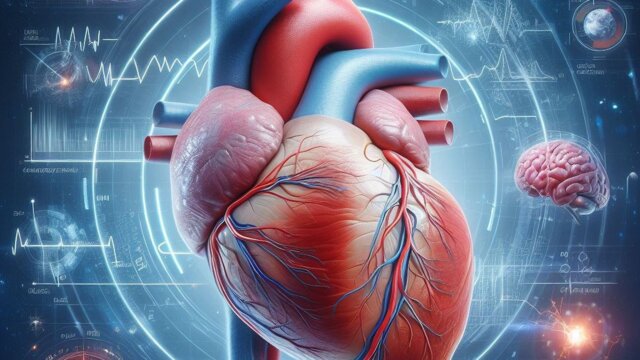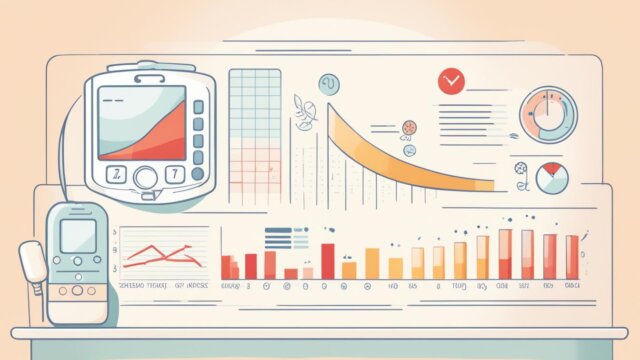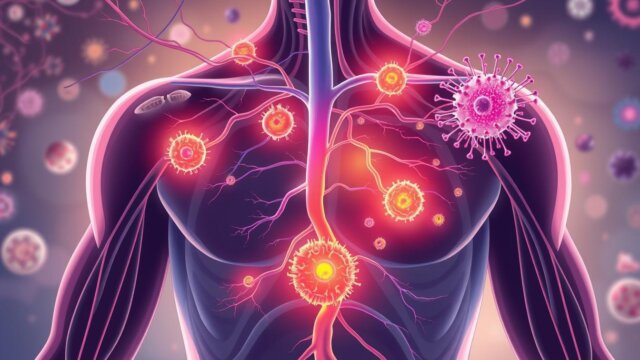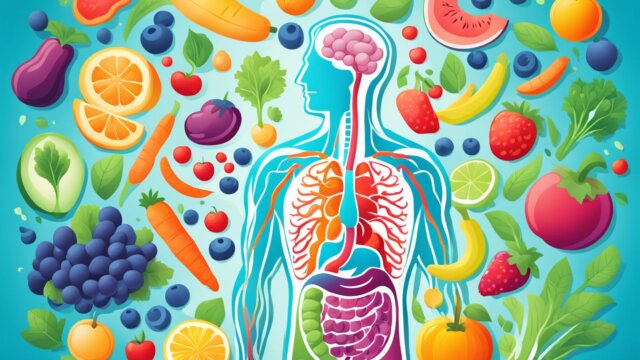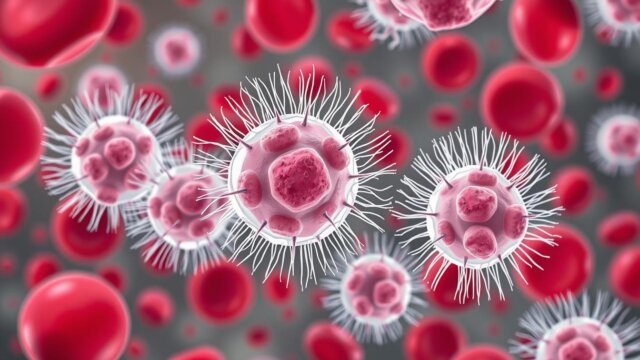FTC disclaimer: This post may contains affiliate links and we will be compensated if you click on a link and make a purchase.
Breast cancer is the most common cancer in women in the United States after skin cancer. It affects about 1 in 8 women in their lifetime. The good news is that survival rates have gone up. Now, over 91% of people with breast cancer are alive five years after being diagnosed.
This improvement is due to better screening and early detection, which have increased the chances of successful treatment.
Yet, breast cancer is still the second leading cause of cancer deaths among women, after lung cancer. This shows how vital it is to keep learning, spreading awareness, and supporting those touched by this disease. Knowing the symptoms, causes, and risk factors helps you watch your breast health closely. If you notice any changes, get medical help right away.
Key Takeaways
- Breast cancer is the most common cancer in women after skin cancer, affecting around 1 in 8 women in their lifetime.
- Breast cancer survival rates have been increasing thanks to advancements in screening and early detection.
- Despite the progress, breast cancer remains the second leading cause of cancer deaths among women.
- Understanding the symptoms, causes, and risk factors of breast cancer is crucial for early detection and effective treatment.
- Staying breast-aware and performing regular self-exams can contribute to the early detection of breast cancer.
Breast Anatomy
It’s important to know how the breast works to spot changes that might indicate cancer. The breast has glandular, fibrous, and fatty tissues that help shape it.
The breast has 15 to 20 lobes of glandular tissue for milk production. These lobules are linked to ducts that carry milk to the nipple. Most of the breast is fatty tissue, making it soft and full.
Breast Tissue Structure
The breast has glandular, fibrous, and fatty tissues. Glandular tissue makes and moves milk. Fibrous tissue gives support. Fatty tissue makes the breast soft and shaped.
Milk Ducts and Lobules
Lobules in the breast make milk, which ducts carry to the nipple. Lymph nodes in the breast and nearby areas help fight infections. They make lymph, which has white blood cells.
Mammograms are key for finding breast problems. They help find cancer early. Dense breasts might need extra tests like ultrasounds or MRIs.

The breast is a complex system with many parts working together. Knowing how these parts work is key to spotting cancer early and getting help fast.
What is Breast Cancer?
Breast cancer starts when cells in the breast grow too much. These cells can form a tumor that grows and spreads. It usually begins in the milk ducts or lobules, where milk is made.
Many factors can cause breast cancer, like genes and the environment. The cancer cells can grow and destroy healthy tissue. In 2022, there were 2.3 million new cases and 670,000 deaths from breast cancer worldwide.
Men can also get breast cancer, but it’s rare. About 0.5-1% of breast cancers are in men. Some genes, like BRCA1 and BRCA2, raise the risk of breast cancer.
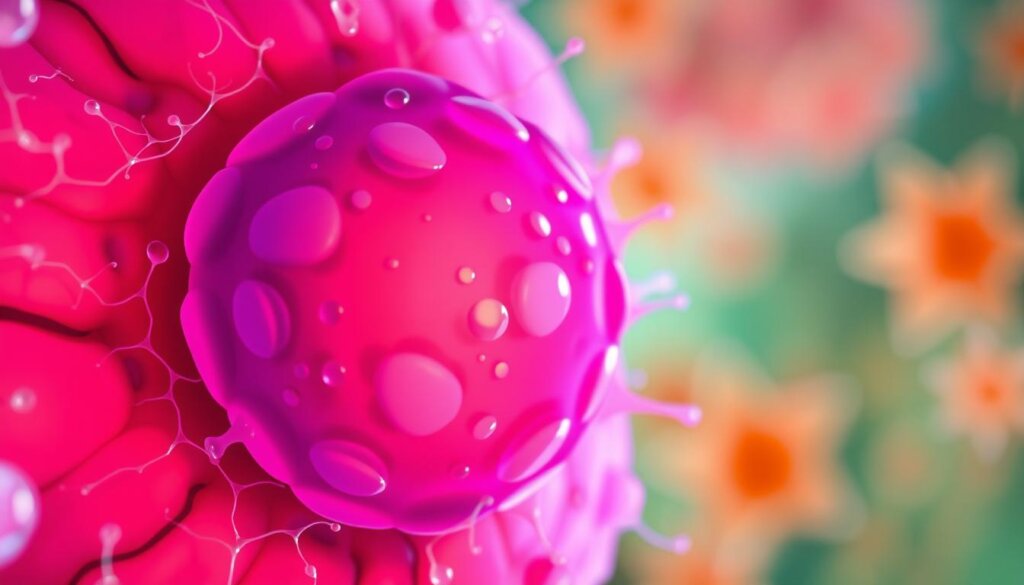
Knowing about breast cancer helps find it early and treat it better. Tests like mammograms can catch it early.
Breast Cancer Symptoms
Breast cancer can show many symptoms. It’s key to tell your doctor about any changes, even if a mammogram is fine. A new lump or mass in the breast is the most common sign.
Other signs include changes in breast size, shape, or appearance, a nipple that turns inward, bloody or clear discharge, and skin changes.
Some changes might be subtle, like feeling the breast tissue thicken. It’s vital to notice any breast changes and tell your doctor. Early detection is key to better treatment.
- A new lump or mass in the breast
- Changes in the size, shape, or appearance of the breast
- A nipple that turns inward
- Bloody or clear nipple discharge
- Changes in the skin of the breast, such as dimpling, puckering, redness, or scaling
- A feeling of thickening in the breast tissue
Symptom | Frequency |
|---|---|
Breast lump | Most common symptom |
Nipple changes | Occurs in some cases |
Breast skin changes | Visible in some cases |
Breast size and shape changes | Possible symptom |
Not all breast changes mean cancer. Still, telling your doctor about any changes is important. Early detection helps a lot.
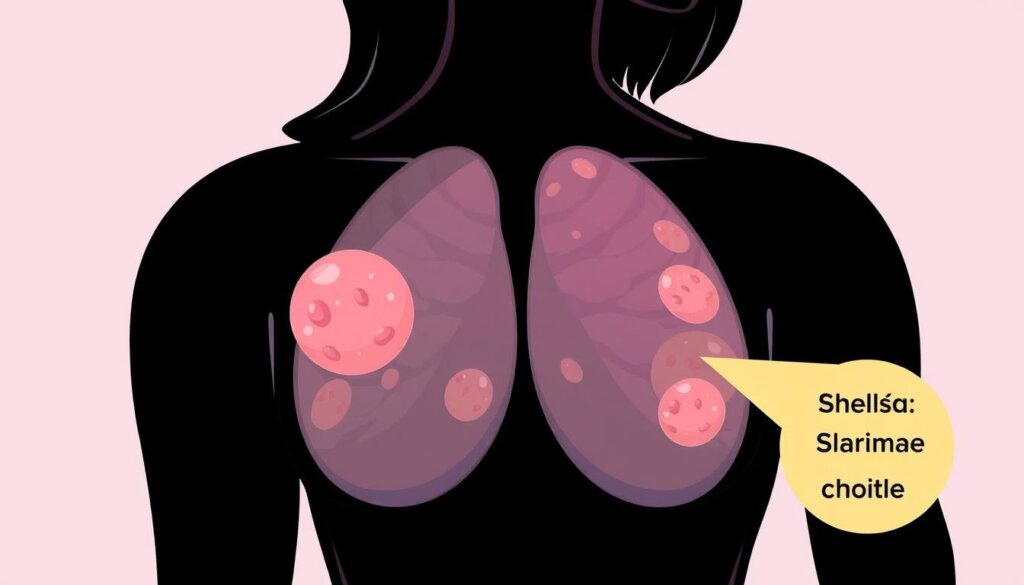
“Breast cancer symptoms can vary greatly from person to person, and it’s important to be aware of any changes in your breast health.”
If you notice any breast changes, see your doctor immediately. Early detection is crucial for effective treatment and better outcomes.
Causes and Risk Factors
Breast cancer is a complex disease with many factors. Researchers have found several risk factors that can increase the chance of getting the disease. These include genetic, hormonal, lifestyle, and environmental factors.
Genetic and Hormonal Factors
Genetic mutations, like in BRCA1 and BRCA2 genes, can greatly raise the risk of breast cancer. Early menstruation, late menopause, and a family history of breast or ovarian cancer also increase risk. Women with dense breast tissue are more likely to get breast cancer.
Lifestyle and Environmental Factors
Lifestyle choices and environmental exposures can also affect breast cancer risk. Obesity, lack of exercise, alcohol, and certain chemicals or radiation can raise the risk. Hormone replacement therapy for a long time and first pregnancy after 30 also increases risk. But breastfeeding may protect against breast cancer.
Having these risk factors doesn’t mean you’ll get breast cancer. But talking to a healthcare provider about them can help. They can discuss ways to reduce risk, like screening, lifestyle changes, or preventive treatments.
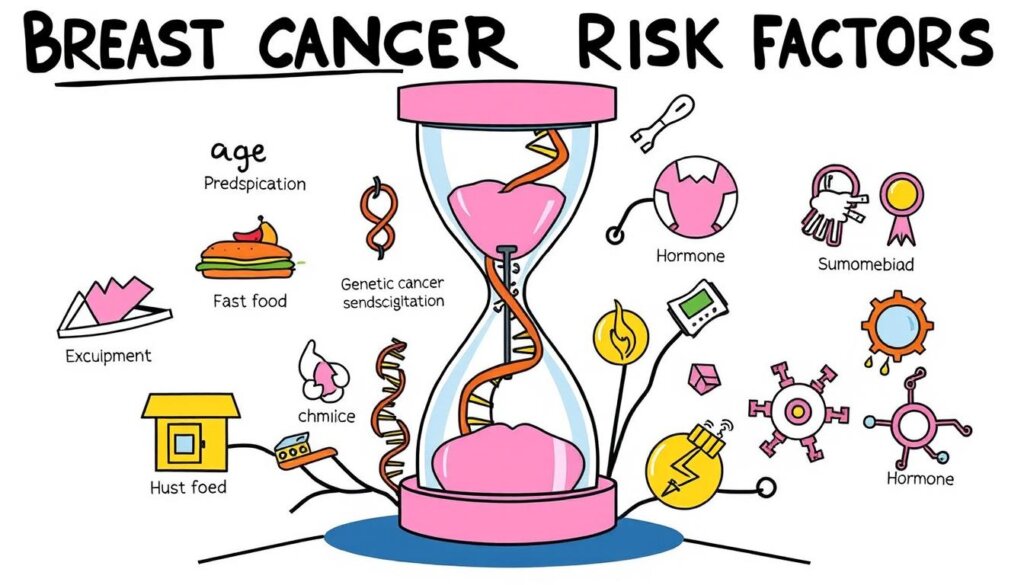
“Breast cancer is a complex disease with various contributing factors. While the exact cause of most breast cancers remains unknown, researchers have identified several risk factors that can increase the likelihood of developing the disease.”
Risk Factor | Impact on Breast Cancer Risk |
|---|---|
Genetic Mutations (BRCA1, BRCA2) | Significantly increases risk |
Early Menstruation, Late Menopause | Increases risk due to longer exposure to hormones |
Dense Breast Tissue | Increases risk |
Obesity and Lack of Physical Activity | Increases risk, particularly after menopause |
Alcohol Consumption | Increases risk, with higher consumption further elevating risk |
Hormone Replacement Therapy | Increases risk when taken for an extended period |
Breastfeeding | May reduce the risk of developing breast cancer |
Breast Cancer Types
Breast cancer is a complex disease with many types. Each type has its own traits and treatment needs. Knowing about these types is key to making a good treatment plan.
Ductal carcinoma is the most common type. It starts in the milk ducts of the breast. Lobular carcinoma begins in the lobules where milk is made. Sarcomas are less common and happen in the breast’s connective tissues.
Breast cancers are also graded, with grade 3 being the most aggressive. Some cancers grow because of hormones like estrogen and progesterone. Others don’t grow because of these hormones. Tests can find the HER2 gene and other markers to help decide treatment.
There are subtypes like Luminal A, Luminal B, HER2 positive, and Basal-like (triple-negative). Luminal A cancers might get better with hormone therapy and chemo. Luminal B cancers need chemo, hormone therapy, and HER2-targeted treatment. HER2 positive cancers do well with chemo and HER2-targeted therapies. Basal-like (triple-negative) cancers are treated with chemo.
Knowing each type’s unique traits is vital for a tailored treatment plan. This plan aims for the best possible results.
Breast Cancer Type | Characteristics | Typical Treatment Approach |
|---|---|---|
Ductal Carcinoma | Most common type, starts in milk ducts | Surgery, radiation, chemotherapy, hormone therapy |
Lobular Carcinoma | Starts in milk-producing lobules | Surgery, radiation, chemotherapy, hormone therapy |
Invasive Ductal Carcinoma | 7-8 out of 10 breast cancer cases | Surgery, radiation, chemotherapy, hormone therapy |
Invasive Lobular Carcinoma | 10-15 out of 100 breast cancer cases | Surgery, radiation, chemotherapy, hormone therapy |
HER2-Low Breast Cancer | Around 50% of breast cancer cases | Chemotherapy, HER2-targeted therapy |
Triple-Negative Breast Cancer | 10-15 out of 100 breast cancer cases | Chemotherapy |
Inflammatory Breast Cancer | Locally advanced, needs immediate treatment | Chemotherapy, surgery, radiation |
In summary, breast cancer comes in many forms, each needing its own treatment. By understanding these types, doctors can create personalized plans. This helps patients get the best care.
Breast Cancer Diagnosis
If a doctor thinks you might have breast cancer, they’ll start with a physical check. They look for any changes in your breasts. They might also use mammograms, ultrasounds, or magnetic resonance imaging (MRI) to see more.
If they find something suspicious, they might take a sample of tissue for a biopsy. This test helps confirm if you have cancer and what kind it is.
Breast cancer is very common in women, making up a big part of new cancer cases. In fact, 1 in 8 women in the US and 1 in 1000 men will get breast cancer at some point. The risk goes up with age, especially for women aged 75 to 79.
In some cases, they might also check your lymph nodes with a lymph node biopsy. This helps doctors plan the best treatment for you. But, not all screenings lead to a cancer diagnosis, and most biopsies don’t find cancer.
Breast Cancer Type | Characteristics |
|---|---|
Ductal Carcinoma In Situ (DCIS) | Nearly all women with DCIS can be cured. |
Invasive Ductal Carcinoma (IDC) | IDC is the most common type of breast cancer. |
Invasive Lobular Carcinoma (ILC) | ILC starts in the milk glands and grows into nearby breast tissue. |
Inflammatory Breast Cancer (IBC) | IBC is more likely to spread and harder to cure than other types. |
Triple-Negative Breast Cancer (TNBC) | TNBC is harder to treat due to missing certain proteins. |
Diagnosing and treating breast cancer has gotten better over time. New tools are being studied to help find cancer early and treat it better. There are also support groups and counselors to help with the emotional side of having breast cancer.
The Susan G. Komen organization helps people with breast cancer. It offers educational materials and helps find navigators. The Breast Care Helpline is available Monday through Thursday and Friday.
“Early detection is key to better prognosis and treatment outcomes for breast cancer. Regular screening and prompt follow-up on any abnormal findings are crucial steps in the diagnosis process.”
Treatment Options
Breast cancer patients have many effective treatment options. Surgery is often the first choice. It can be a lumpectomy or a mastectomy to remove the breast.
Radiation therapy uses beams to kill cancer cells after surgery.
Chemotherapy
Chemotherapy uses drugs to kill cancer cells. It can be used before or after surgery or with other treatments. It’s good for aggressive or advanced breast cancer.
Hormone therapy blocks estrogen to treat hormone-sensitive cancers.
Targeted Therapy
Targeted therapies are new and promising. They target cancer’s genetic or molecular traits for better treatment. Treatment plans are made for each person, using different methods for the best results.
Treatment | Description | Effectiveness |
|---|---|---|
Surgery | Lumpectomy or mastectomy to remove the tumor and/or breast tissue | Highly effective for early-stage breast cancer |
Radiation Therapy | High-energy beams are used to kill cancer cells and prevent recurrence | Effective in combination with surgery or other treatments |
Chemotherapy | Powerful drugs that destroy rapidly dividing cancer cells | Helpful for more aggressive or advanced breast cancer |
Hormone Therapy | Blocks or lowers the body’s production of estrogen to starve hormone-sensitive breast cancers | Effective for hormone-sensitive breast cancers |
Targeted Therapy | Drugs that target specific genetic or molecular characteristics of the cancer | Promising new approach for personalized treatment |
The best treatment for breast cancer is a mix of therapies. This approach helps each patient get the best care.
Breast Cancer Prevention
There’s no sure way to stop breast cancer, but you can lower your risk. Regular screening like mammograms and exams can find cancer early. Knowing your breasts through self-exams helps spot changes early.
Healthy habits are key to preventing breast cancer. Staying at a healthy weight, exercising, and drinking less alcohol can help. If your family history is high or you have certain genes, tests and extra checks might be needed.
While you can’t prevent all breast cancers, these steps can help. They increase your chances of finding cancer early and treating it well. Breastfeeding also helps, especially if you do it for a long time.
Lifestyle Factor | Impact on Breast Cancer Risk |
|---|---|
Alcohol Consumption | Increased risk, even with small amounts |
Physical Activity | Reduced risk with at least 150 minutes of moderate aerobic exercise per week |
Healthy Weight | Decreased risk, with a 10-pound weight loss reducing risk by 32% |
Breastfeeding | Reduced risk, with longer durations offering greater protection |
While these steps can lower your risk, they don’t promise prevention. Early detection and a healthy lifestyle are crucial for managing breast cancer risk.
“Up to 70 percent of breast cancers can be prevented by adopting risk-reducing behaviors.”
Conclusion
Breast cancer is a tough disease, but we’ve made big steps forward. We’ve learned more about early detection, treatment, and support for those affected. We’re getting better at fighting this disease thanks to research, education, and advocacy.
Knowing the symptoms, risks, and treatments can help people manage their health and find the support they need.
With new medical discoveries and a focus on care, the outlook for breast cancer patients is good. Breast cancer is common in women worldwide. But finding it early and treating it fast can really help people survive.
By knowing the facts and pushing for fair access to care, you help fight this disease. You also support those on their journey to recovery.
We can all help by spreading the word, funding research, and offering support. No one should face breast cancer alone. Together, we can make breast cancer easier to manage and treat. This way, everyone affected can live a full and meaningful life.
FAQ
What is breast cancer?
Breast cancer starts in the breast tissue. It can spread to other parts of the body. It’s the second most common cancer in women in the U.S., after skin cancer.
What are the symptoms of breast cancer?
A new lump or mass in the breast is the most common symptom. Other signs include changes in breast size, shape, or appearance. A nipple that turns inward or bloody discharge is also a sign.
Changes in the skin, like dimpling or redness, can also indicate breast cancer.
What are the risk factors for breast cancer?
Genetic and hormonal factors increase the risk. This includes a family history of breast cancer and certain genetic mutations. Early menstruation or late menopause also raises the risk.
Lifestyle and environmental factors like obesity and alcohol use can also play a role.
What are the different types of breast cancer?
Ductal carcinoma starts in the milk ducts, and lobular carcinoma starts in the milk-producing lobules. Breast cancers can be in situ or invasive, depending on their spread.
How is breast cancer diagnosed?
The process starts with a physical exam and imaging studies, such as mammograms. If a suspicious area is found, a biopsy is performed, which involves taking a tissue sample for analysis.
What are the treatment options for breast cancer?
Treatments include surgery, radiation, chemotherapy, hormone therapy, and targeted therapies. The plan depends on the cancer’s stage and type.
Can breast cancer be prevented?
Preventing breast cancer is not guaranteed. But, steps can lower the risk. These include regular screening, a healthy lifestyle, and genetic testing for those at high risk.


